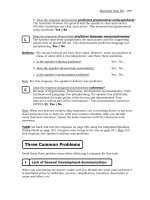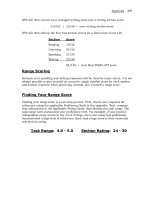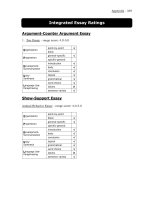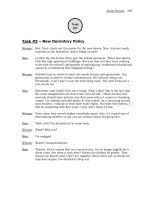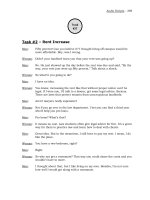Success Strategies for the Aesthetic Dental Practice pptx
Bạn đang xem bản rút gọn của tài liệu. Xem và tải ngay bản đầy đủ của tài liệu tại đây (2.1 MB, 29 trang )
Linda Greenwall, Cathy Jameson
Success Strategies
for the Aesthetic Dental Practice
London, Berlin, Chicago, Tokyo, Barcelona, Beijing, Istanbul, Milan,
Moscow, New Delhi, Paris, Prague, São Paulo, Seoul, Singapore and Warsaw
v
Foreword
Ronald E Goldstein, DDS
Aesthetic dentistry has become so important in the last several decades that
a book which condenses all of the techniques for the business side of aes-
thetic dentistry is certainly needed. Written by two of the leading authorities
on this important aspect of dentistry, both Drs Linda Greenwall and Cathy
Jameson have accumulated a tremendous amount of knowledge to condense
the important information into easy to read chapters. I have worked with
both authors and admire and respect their contributions to dentistry. Per-
haps the real reason this book will resonate with the dental reader is that
it combines the skills of an excellent dentist with the equal skills of one of
dentistry’s best practice administrators and coaches.
The book begins where it should, focusing on the individual dentist den-
ing his or her goals for the dental practice. Without vision at the outset it is
virtually impossible to make the most out of the next steps in the process of
creating the ideal environment for maximum success. Next, it logically pro-
ceeds to building the team and here the authors get quite specic, especially
in the interview process. This is an area that most dentists are hardly skilled
to master, but after reading this chapter they certainly will be. Frankly, this
chapter alone is well worth the price of the book.
I found it quite interesting that the next area of discussion is marketing
… after all, you need to attract the type of patients you are building your
practice for, and so internal and external marketing are covered very well.
Both treatment planning and case presentation are well thought out. Most
every dentist will take away tips in these areas regardless of how well the
processes are handled now. Certainly one of the most important chapters
deals with communication skills for the entire dental team. No matter how
well your practice communicates now, you will be able to see improvement
in your daily contacts with patients and the public.
The concept of using a treatment coordinator was rst established by
DrCarl Reider. I published how important I thought it was in the second edi-
tion of Esthetics in Dentistry, and I am so pleased the authors devote an entire
chapter to the role of this person. This leads to the next chapter which deals
with the nancial aspect of aesthetic dentistry, followed up by what every
practice needs to improve on: scheduling. I am delighted to see that a chap-
ter is devoted to the hygienist’s role in promoting aesthetic dentistry since
this is certainly a prime area that too many dental practices take for granted.
vi
Foreword
The last chapters are also well placed and deal with the use of technology
in building the aesthetic dental practice. Over 25 years ago, Dr Jack Preston
and I staged the very rst comprehensive show devoted to new technol-
ogy and how it could enhance our dental practices. Today it is a necessity
if dentists want to practice state of the art aesthetics. The ability to have our
patients’ restorations last as long as possible is directly related to the tech-
nical equipment and abilities wrapped up in both diagnosis and treatment.
No doubt the future will be even more dependent on sophisticated technol-
ogy as a major part of every dental practice.
One of the best ideas the authors use throughout the book are action steps
at the end of each chapter. These summary tips make it easier to apply the
information rather than just reading and forgetting, and to take action where
action is needed.
The sum total of the benet of understanding and using the principles
expounded in Success Strategies in Aesthetic Dentistry is that if you want to
expand the cosmetic side of your dental practice, then this book is essential
reading.
vii
Preface
Linda Greenwall, BDS (Rand), MGDS RCS (Eng), MSc
(London), MRD RCS (Eng), FFGDP
Many dentists focus primarily on doing the best clinical dentistry that they can.
They concentrate on all the clinical skills that they have been taught at dental
school, which leads to a dedication to clinical excellence. This pathway can be
frustrating when they do not get to do the dentistry they love as they do not
have enough patients saying yes to treatment, or the cases to perform the beau-
tiful aesthetic dentistry that they know they can provide for their patients. Get-
ting patients to say yes takes time. There are certain techniques and systems
that should be in place in order to make this happen, including excellent prac-
tice management systems and an excellent dental team. Dentists do not like to
manage the administrative and management side of the dental practice as they
would rather be doing the dentistry at the chairside. They often leave the man-
agement aspect of the dental practice to happen haphazardly. This leads to frus-
tration and stress, which is already very high within a dental practice.
As a newly qualied Prosthodontist and Specialist in Restorative Dentistry
in 1993, I opened my new dental practice in London the day after completing
the specialist examinations. I had very few patients at the beginning, as I started
the dental practice from scratch. The end of that same week I had my second
child. I took off 8 days from work and returned with the baby in a basket. I
thought the dental practice would develop at a slow pace as the baby grew and
developed. About 6 months after starting the dental practice, a local journalist
came to interview me to coincide with the ofcial launch of the new practice.
The article appeared in the local newspaper. The day the article was published,
the telephone starting ringing off the hook. We must have had 500 new patients
call to schedule an appointment in one day. It was very exciting! However, the
excitement soon died down when I realized that these new patients all needed
to be seen, assessed, and treatment planned, and we needed to schedule them
for treatment. I had no practice systems and thought that we would make it up
as we went along, as other dentists do. These great new patients who lived in the
local vicinity were used to the best service in restaurants and hotels, and I was
not sure that we could live up to their expectations.
I came across a book written by Dr Cathy Jameson called Great Communica-
tion Equals Great Production (PennWell Books, 1995). It immediately grabbed
my attention as it reected my attitude as to how I would like to look after my
patients and manage my dental practice. After delivering my rst baby I felt
frustrated that I was not part of the decision making process and wanted to be
viii
Preface
involved in the decisions about my treatment and the way the baby was to be
delivered. I felt that if I was the patient, I would like the care giver to discuss
the treatment options rst and to discuss the process and treatment prior to
commencing clinical treatment. Cathy’s book reected what I wanted to put
into practice but I did not know how to do it. I contacted Cathy about her book
and she offered to travel to London to teach me the systems to run my practice
and so develop an excellent dental practice focusing on aesthetic dentistry. My
team and I continue to train with Cathy every year since then.
We wanted to write this book together as there are many beautiful clinical text-
books devoted to doing the best clinical dentistry but very few textbooks that focus
on the practice management side, which needs to be in place for the clinical side to
be excellent. There are few books on how to develop the best dental practice that
is patient focused, taking into consideration their hopes and aspirations in order
to provide the dental aesthetics that the patients want. The book is meant to be a
practical guide to help dentists develop systems in their dental practice that work
well and that help the practice to grow and elevate to the next level each year.
As dentists are very busy wearing many different hats or fullling differ-
ent roles in the practice, systems that follow checklists have been developed to
assist the dentist and their team to organize themselves practically. Checklists
help to reduce stress and to be better prepared for each stage along the patient’s
journey. Checklists help the dental team to prepare organizationally and clini-
cally and reduce errors and problems. Dr Atul Gawande (2009) wrote a book
called The Checklist Manifesto and demonstrated that those professionals who
use checklists have fewer errors and complications in all that they do. Checklists
for aesthetic dentistry and management aspects have been specially compiled
in this book in each chapter. At the end of each chapter there are action points,
checklists, and further reading with references. Using these will help focus the
dental practice to become well organized in a step-by-step manner.
This book does not deal with the complex compliance issues that are legal
requirements in the dental practice within particular states or countries. It
deals with the essential aspects that are relevant for all dental practices to
develop, regardless of state or country. Many dental practices focus on pro-
viding aesthetic dentistry either solely or exclusively, and this book has been
formulated especially for those practices. However, all dentists provide aes-
thetic dentistry whether it is on one tooth, a posterior quadrant, or the whole
mouth. Many dentists would like to do more aesthetic dentistry but do not
know how to attract those patients who want this treatment. There are also
patients within the dental practice who request aesthetic dentistry, whether it
is for a major milestone in their lives, to feel better about themselves in general,
or to improve their self condence and their smiles. This book will help den-
tists to create the organizational structure to make these aesthetic cases hap-
pen. A well-organized dental practice reduces stress levels, which helps keep
the dentist and their team happy. This happiness reects on the whole practice
and the whole team. Patients notice this and realize that this is a happy dental
practice to visit, becoming loyal patients and raving fans.
We hope that you nd the book useful and look forward to hearing from
you.
1. Gawande A. The Check-
list Manifesto: How to get
things right. New York:
Picador, 2009.
2. Jameson C. Great Com mu-
nication Equals Great Pro-
duction. Tulsa, OK: Penn-
Well Books, 1995.
Further resources are
available at www.james-
onmanagement.com
and www.lindagreen-
wall.co.uk.
References
ixix
Acknowledgements
Writing, compiling, and collating this book has taken dedicated time, late
nights, and time stolen from many other things. I thank my husband Dr
Henry Cohen for his love and encouragement, and sons Andrew, Joseph,
Edward, and Rayno for their love, support, and understanding of my absence
from them while writing this book.
My mother, Shirley, a feisty lady with high energy and a positive attitude,
has always given clear directions on the path to follow and enjoyed the jour-
ney even with the bumps along the way. Thank you!
My father, the late Dr Ryno Greenwall, was my inspiration to become a
dentist. I enjoyed being part of the family dental practice, practicing together
with my father and grandfather, the late Dr Edward Greenwall, in Cape
Town, South Africa. I needed the wise counsel and advice, benetting from
your combined 97 years of experience in dental practice and practical tips on
treating patients. I miss that now.
To my teachers, mentors, and dental colleagues, I appreciate your input
and clear guidance.
To my dental family, my practice team, hygienists, dental therapists, and
Diane Rochford for all of your help and assistance. Thank you for all your
support, hard work, and fun along the way.
To the dentists who refer their patients to the practice to provide aesthetic
dentistry, thank you for your trust and respect.
To my patients, who have given me the honor and privilege of being part
of their lives, thank you.
Gratitude to God for his blessings, insight and wisdom.
Do not say I will study when I have the time, for you may never have the time.
Pirkei Avot 2:4
The more study, the more wisdom. Pirkei Avot 2:8
“
”
Linda Greenwall
x
Acknowledgements
To Sarah Jewell and Rachel Grosvenor who have helped immensely in
compiling this manuscript, inserting photos and preparing newsletters, and
with many of our projects that we undertake in the practice. Thank you!
To Dr Ron Goldstein, thank you for sharing your wisdom with me and for
your foreword.
To Dr Mike Wise, Dr Mervyn Druian, Dr Cherilyn Sheets, Drs Kim and
Basil Mizrachi, Dr Gerry Curatola, Drs Larry and Bob Rifkin, thank you for
your contributions and sharing your success strategies.
To Dr Oded Bahat and his assistant Reina Ramirez for your help with our
implant treatment planning, implant surgery, and CT scan checklists, and
constant reality checks!
To Cathy, thank you for your teaching of the Jameson systems, dedication,
and being tough talking when things needed to be done, a guiding coach
and great friend. Without you I would not have been able to build and grow
my aesthetic dental practice in London. Thank you.
Where do I begin to acknowledge the many people who have inuenced this
body of work – and, indeed, my lifetime? There have been so many people
who have supported me on my path. I am grateful to each one of you.
First of all, I acknowledge the love and grace of God Almighty for His
strength, guidance, and careful “watch.”
My husband, my favorite dentist, and my cowboy hero, Dr John Jameson.
Thanks for letting me “test” all my theories of practice management in your
practice, which became the launching pad for Jameson Management, Inc.
Who could have ever guessed ‘the rest of the story’? You are the best.
My wonderful family who don’t always understand why I work such
long, tedious hours, but always seems to be glad when they see me pop my
head up for air! Our son, Dr Brett Jameson, his wife, Amy, and kids, Lauren
and Cody. Our daughter, Carrie Jameson Webber, Director of Marketing for
Jameson and her husband, Jess Webber, President and CEO of Jameson, and
their sons Benjamin and Keller. Thanks to my father, Derry Ebert, where I
learned my work ethic and to my mother-in-law, Dorothy Strong Jameson
(MiMi) who is always there – for anything.
Thanks to my Jameson Management, Inc. family, which is the best team
EVER! Thanks for your willingness to learn from me and for taking such
good care of our clients. Your devotion and dedication to our “method” and
to the integrity with which we interact with each client has been a major part
of the longevity and legacy of Jameson.
A special expression of gratitude to Amy Logan Parrish for her total and
complete dedication to me and to the entire Jameson team. You always ‘step
up to the plate’ to help on any project, including this book. You are a blessing
to me and to every person with whom you interact. You are amazing.
Cathy Jameson
xi
Acknowledgements
Rachel Leslie, thank you for sharing your brilliant graphic design and
photographic know-how. Your creativity is priceless. To John Jameson, Misty
Clark, Dru Halverson and Nancy Dukes, thanks for your contributions to
this book.
A special note of gratitude to Alan Cohen, my personal coach. Alan, how
do I express my appreciation for your honest and caring support, as well as
your personal insights into ‘writing from the heart’?
Thank you to Dr Jean Gordon, my faculty mentor from Walden Univer-
sity, where I completed a doctorate in management in June of 2010. Dr Gor-
don, you epitomize the very best in education. Your unwavering guidance
and straightforward instruction made this tedious journey meaningful and
successful.
And a special note of heartfelt love and gratitude to my friend, colleague,
and mentor, Jeff Gelona.
Thanks to all of the clients throughout time who have given us the privil-
ege of coaching you and your team. You honor us with your trust. Our suc-
cess is based on your success. A special note of gratitude to the Jameson
clients, team members, and friends who have participated in this book: Drs
John Jameson, Ken Hamlett, Charles Puntillo, Mark Hyman, Jill Wade, Galip
Gurel, Larry Rosenthal, and Bete Johnson from Care Credit.
To all of the people who have come to my lectures and seminars through-
out time, thank you. My intention is always to shares ideas and insights that
will make a positive difference in your practice and life. May the learning be
about “life management,” as well as practice management.
To Quintessence, thank you for the trust you have shown by publish-
ing this book, which is a lifetime accumulation of experience, learning, and
study. To have you as the publisher of this book is a dream come true. You
honor me, and it is my sincere hope that this book will honor you and your
readers.
And, nally, a special note of love and thanks to my client, colleague, and
friend, Dr Linda Greenwall, one of the most entrepreneurial women I have
ever known. You are a visionary, a ne businesswoman, a wonderful wife,
daughter, sister, and mother. You are a leader extraordinaire. You never stop
learning. Your passion for continuous improvement is steadfast. I honor,
respect, and absolutely love you! This book has been a long-term goal of
ours, and its time has come. What a privilege to have written it with you.
Here’s to our lifetime of friendship.
xii
Authors and Contributors
Linda Greenwall,
BDS (Rand), MGDS
RCS (Eng), MSc
(London), MRD
RCS (Eng), FFGDP,
Private Practice,
Hampstead, Lon-
don; Specialist in
Restorative Den-
tistry; Specialist
in Prosthodontics;
Editor-in-Chief of
Aesthetic Dentistry
Today
Cathy Jameson,
PhD, MA, BS,
Founder and CVO
of Jameson Man-
agement, Inc.,
Adjunct Faculty
Member Oklahoma
University Col-
lege of Dentistry,
Member of the
Oklahoma State
University Board
of Trustees
Featured
contributors
Cindy Butler,
Business Adminis-
trator, Dr Charles
Puntillo’s practice
Misty Absher
Clark, VP of Cre-
ative Ser vices,
Jameson Manage-
ment, Inc
Nancy Dukes, BA,
RDH, CBM, Direc-
tor of Clinical Con-
sulting, Jameson
Management, Inc
Galip Gürel, DDS,
Dentis Dental
Clinic, Istanbul,
Turkey; Founder
and Honorary
President of Turk-
ish Academy of
Esthetic Dentistry
Debra Hamlett,
Business Admin-
istrator, Kenneth
Hamlett, DDS, Dal-
las, Texas
Ken Hamlett,
DDS, Clinician at
Kenneth Hamlett,
DDS, Dallas, Texas;
Se nior Clinical
Instructor at the
Rosenthal Institute
Dru Halverson, BS,
RDH, Director of
Quality Assurance,
Jameson Manage-
ment, Inc
xiii
Authors and Contributors
Mark Hyman,
DDS, MAGD,
Clinician at Mark
Hyman, DDS,
Greensboro, North
Carolina
John Jameson,
DDS, Chairman of
the Board, Jameson
Management, Inc
Bete Johnson,
Director of Busi-
ness Development,
Care Credit
Shana Munson,
Treatment Coordi-
nator and Market-
ing Director, Dr
Tuyen Nguyen Soft
Dental, Rush City,
Minnesota
Amy Logan
Parrish, VP of
Development,
Jameson Manage-
ment, Inc
Larry Rosenthal,
DDS, PC, Clinician
at Rosenthal/Apa
Group New York,
New York; Founder
and Clinical Direc-
tor of Rosenthal
Institute, Aesthetic
Advantage and
Aesthetic Advan-
tage Continuum
Jill Wade, DDS,
MAGD, Clinician
at Stonebriar Smile
Design, Frisco,
Texas
Jacqueline Pastore,
Practice Adminis-
trator, Rosenthal/
Apa Group New
York, New York
Charles Puntillo,
DDS, Clinician at
Charles Puntillo,
DDS, Burlington,
Wisconsin
xiv
Authors and Contributors
Oded Bahat, DDS,
Implant Surgeon
and Periodontist,
Beverley Hills,
California
Gerry Curatola,
DDS, Aesthetic
Dentist, New York,
New York
Mervyn Druian,
BDS (Rand), DGDP
RCS, Cosmetic
Dentist, London
Ron Goldstein,
DDS, Clinical Pro-
fessor, School of
Dentistry, Medical
College of Georgia,
Augusta, Georgia
David Klaff, BDS,
Prosthodontist and
Aesthetic Dentist,
London
Basil Mizrahi,
BDS, MSc (Rand),
Prosthodontist,
London
Larry Rifkin, DDS,
Cosmetic Dentist
and Prosthodon-
tist, Beverley Hills,
California
Cherilyn Sheets,
DDS, Prostho-
dontist, Newport
Beach, California
Michael Wise,
BDS, MScD, LD
SRCS, FDS RCS,
Specialist in Restor-
ative Dentistry
and Oral Surgery,
London
Other
contributors
xv
Contents
Chapter 1
Introduction 1
Cathy Jameson and Linda Greenwall
Chapter 2
The Foundation: Mission, Vision, Goals 9
Cathy Jameson and Linda Greenwall
Chapter 3
The Critical Factors of the Business of Dentistry 25
Cathy Jameson and Linda Greenwall
Chapter 4
The Most Critical Factor: The Team 41
Cathy Jameson and Linda Greenwall
Chapter 5
Internal Marketing 57
Cathy Jameson, Linda Greenwall, and Misty Absher Clark
Chapter 6
External Marketing 79
Cathy Jameson, Linda Greenwall, and Misty Absher Clark
Chapter 7
Communication Skills 91
Cathy Jameson and Linda Greenwall
Chapter 8
The Business of Bleaching and Tooth Whitening 105
Linda Greenwall and Cathy Jameson
Chapter 9
Treatment Planning and Diagnosis of Aesthetic Dentistry 131
Linda Greenwall and Cathy Jameson
Chapter 10
Effective Case Presentation 167
Cathy Jameson and Linda Greenwall
xvi
Contents
Chapter 11
Developing the Role of Treatment Coordinator 195
Cathy Jameson and Linda Greenwall
Chapter 12
Financing Aesthetic Dentistry 207
Cathy Jameson and Linda Greenwall
Chapter 13
Scheduling Aesthetic Dentistry 225
Cathy Jameson and Linda Greenwall
Chapter 14
The Hygienist’s Role in Promoting Aesthetic Dentistry 241
Cathy Jameson and Linda Greenwall
Chapter 15
The Use of Technology in Building the Aesthetic Aspect
of a Dental Practice 255
Cathy Jameson, Linda Greenwall, and John Jameson
Chapter 16
Continuing Education 275
Cathy Jameson and Linda Greenwall
Chapter 17
In Conclusion 287
Cathy Jameson and Linda Greenwall
Index 289
8 The Business of Bleaching and Tooth Whitening
108
START
Patient has no
preoperative
sensitivity
Patient complains of existing sensi-
tivity before bleaching teeth/tran-
sient sensitivity to:
→ Cold: check recession
→ Heat: check pulpitis
→ Pain on biting: check for fracture
→ Sweet: check caries
No treatment
required
Proceed with
bleaching
Diagnose
and treat
appropriately
Sensitivity
during
bleaching
→ Brush with desensitizing toothpaste for 2
weeks before bleaching
→ Continue bleaching during treatment
→ Continue brushing with desensitizing
toothpaste for 2 weeks after bleaching
treatment is completed
No Yes
Continue
bleaching
Stop bleaching
for one night
Continue
bleaching
Pain relief
No pain relief
Apply proprietary desensi-
tizing gels onto teeth that are
sensitive or cervical margins
that display sensitivity
→ Fluoride gel
→ Potassium nitrate
→ Amorphous calcium
phosphate
No pain
relief
Apply local agents at chairside
such as:
→ bonding agent
→ glass ionomer restoration
Cut back 1–2 mm off the margin of
the bleaching tray
Complete bleaching with excellent
result
Fig 8-2 Treatment sequence for managing bleaching sensitivity.
crack lines
white spots
internal tooth shading, characterizations
shading of the teeth, anterior and posterior maxillary and mandibular
tooth wear
existing composite restorations
Shade assessment 8
109
non-vital teeth
single yellow vital teeth
deeper stains or markings
amalgam staining
type of discoloration, eg, tetracycline or uorosis stain
white markings
chronological age when damage occurred
presence of caries or abscesses.
Assess the patient’s baseline shade. Record the shade of the six anterior max-
illary teeth as these can all be different. Record the shade of the mandibular
teeth. Often there can be a discrepancy between the shade of the maxillary
and mandibular teeth. The basic assessment uses the porcelain shade guides
(Figs 8-3 and 8-4). Show patients on the shade guide what they may hope to
achieve from a realistic point of view. Do not promise something that cannot
be achieved in terms of whiteness. Many patients want the whitest shade
available and this may not always be possible: further aesthetic dentistry
may be necessary. Some patients have all anterior teeth a different shade and
this should be individually recorded (Fig 8-5).
Shade assessment
Fig 8-3 Shade assessment. It is essential to involve the patient in
the discussion about the shade before, during and after whiten-
ing. In this gure the patient is involved in the discussion about
the shade of the teeth and uses a mirror to look at the shade guide
in comparison to the shade of the teeth.
Fig 8-4 The classic Vita shade guide
is used to assess the change in color
after the whitening treatment. A com-
parison is made with the shade of the
white of the eyes, as after completion
of whitening treatment the white of
the eyes should match the shade of
the teeth.
8 The Business of Bleaching and Tooth Whitening
128
Procedure: Power bleaching (Fig 8-16)
Time: 2 hours
Greet and seat patient, check medical history.
Check the consent form is signed.
Explain the procedure to the patient.
Take a shade.
Take preoperative photos (with a blue background).
Apply face cream, Vaseline to the lips
Place retractors in patient’s mouth, long cotton wool rolls, and napkin.
Apply liquid dam, tack to cotton wool.
Apply gauze to protect soft tissues including cheeks.
Apply bleaching gel to the teeth.
Position the Zoom 2 light, make sure it is correctly lined up.
Light is on for 15-min intervals.
Remove gel and rehydrate teeth with water and cotton wool rolls.
Repeat procedure two more times.
Following third cycle, remove liquid dam and cotton wool rolls.
Ask patient to rinse (plain water).
Apply uoride gel to teeth.
Take postoperative photos.
Postoperative instructions, trays, and material supplied to patient if con-
tinuing with home bleach.
Complete documentation.
Ask patient if they have any questions, run through what treatment has
been carried out today, and what to expect at their next visit.
Schedule next appointment.
Decontaminate surgery and set up for next patient.
Fig 8-15 Items required for set-up of bleaching
review (Appendix 8-5).
Fig 8-16 The power bleaching procedure in
progress.
Appendix 8-5 8
129
To set up, and instruments for power bleaching procedure (Fig 8-17)
Patients notes, current radiographs (ensure the radiographs are up on
computer monitor).
Patient bib, glasses.
Gloves, mask, and shield.
Mouthwash (colorless), salivary ejector, wide bore suction and surgical
suction tip.
Basic examination tray (mirror, probe, and tweezer).
Camera, shade guide, retractors.
Cotton wool rolls (long and short), gauze, napkin, retractor, Q-tips.
Face cream, Vaseline, dappens dishes, cotton rolls.
Suction tips, applicator brushes.
Liquid dam.
Power bleaching material and light.
Soothers (uoride gel, potassium nitrate, and amorphous calcium phos-
phate).
Fig 8-17 Tray set up
and additional items
required for power
bleaching treatment
using Philips Discus
products (Appendix 8-5).
10 Effective Case Presentation
178
goals. I’d like to invite you back to the ofce in about a week so that we
can sit down together uninterrupted to discuss my recommendations.
Would that be acceptable to you?”
Once a person says yes to the consultation, ask them one more very
important question:
Dentist: “Rachel, other than yourself, who will be deciding how you pro-
ceed with your treatment?”
Figs 10-11a to 10-11k Tour of
the mouth photographs (photo-
graphy by Misty Absher Clark).
Find out if there are other decision makers involved. There is no reason to
call for a decision if the decision maker is not there. Determine the decision
makers and make effort to schedule your consultation at a time when both
a b c
d e f
g h i
j k
Step 2: Establish the need 10
179
parties can be in your ofce. Dental decisions are not made sitting around the
dining table, they need to be made at your dental practice where you have
the visual aids and the professional information. However, if you cannot get
all decision makers at the consultation and if you have used our protocol for
Digital Case Presentation© (see Appendixes 10-1 and 10-2), the resulting CD
can provide visual and written support of your treatment plan if decision
makers are not present.
Don’t think that people will not come back for a consultation. They will be
happy to return. You are going to change their smile. They are going to make
a signicant investment, and so need to be informed. They will come back.
Give yourself and your patients the time and attention needed to make this
major decision. A quick discussion at the chair is not the avenue to gaining
high levels of case acceptance.
Schedule the consultation appointment within one to a maximum of two
weeks following the initial evaluation (Fig 10-13). The patient’s interest will
be at its highest level. Letting too much time pass before the consultation
could lead to waning interest.
Treatment planning
Once you have completed the comprehensive evaluation, schedule time to
design a treatment plan that is optimal for the patient. Plan your cases while
the information is fresh in your mind and before the patient comes back for
their consultation appointment. Careful planning and documentation will
support your care of the patient throughout their time with you. Your team
can only perform well in all of their roles if a carefully designed treatment
plan is a part of the patient record. Team members cannot make excellent
nancial arrangements nor can they schedule appointments properly if they
don’t have a carefully documented treatment plan. Failing to plan will reduce
your rate of case acceptance.
Refer to the chapter on the treatment coordinator (Chapter 11). The devel-
opment of this role in your dental practice can lead to higher levels of case
Fig 10-12 Return consultation invitation. Fig 10-13 Scheduling the consultation appoint-
ment.
15 The Use of Technology in Building the Aesthetic Aspect of a Dental Practice
258
Fig 15-4a Using the intraoral
digital scanner will reduce the
need for impression taking using
trays and impression material.
Once the dentist has been trained
in using the scanner to record the
prepared teeth, this will improve
accuracy and speed. The scanner
transfers the information via the
internet directly to the dental lab-
oratory in order to save time. The
picture shows the Cadent iTero
scanner (Cadent, Carlstadt, NJ).
Fig 15-4b The scanner head in
close up view. The black part of
the head needs to be position ed
directly over the tooth and
recorded in three dimensions.
Fig 15-4c The scanner being
used clinically. As with all tech-
nology, it is essential that further
training is undertaken to ensure
the best use and full capabilities
of the technology.
Fig 15-4d Careful positioning of
the intraoral scanner is essential.
Fig 15-4e The scanner head
being placed in the patient’s
mouth, ready to commence the
scanning process.
Organization and storage of visual data 15
259
Fig 15-5 Dr Larry Rifkin using the microscope for
aesthetic clinical procedures. He has an attachment
for the digital camera that ts onto the microscope in
order to record clinical procedures. The microscope
also has the ability to record videos. This is useful
for teaching and for showing to patients.
Fig 15-6 Using the operating microscope for aes-
thetic dentistry procedures improves the quality of
the restoration as better visualization is possible.
This helps especially when nishing off margins of
veneer preparations and the polishing of anterior
direct resin composite bondings.
Fig 15-7 The use of dental loupes for magnica-
tion is an essential tool for all aesthetic dentists who
want to improve their clinical procedures and diag-
nosis of problems intraorally.
289
Index
3D image technology 263–4
4Ps of professionalism 202
12 critical factors 26–39
25 management systems 35–6
A
acceptance see case acceptance
accountability 22, 47
accounting reduction payments 219
accounts collection see collection
goals
accounts receivable 28, 37
acknowledgement responses 97
action-oriented advertising 81–3
action steps 8
case presentation 188–9
communication skills 102
continuing education 284
critical factors 39–40
external marketing 88–9
nancing dentistry 223–4
hygienist’s role 254
internal marketing 74–5
mission/vision/goals 24
scheduling system 240
team members 55
technology use 270
treatment coordinator role 206
treatment planning 151–2
whitening treatment 116
see also plan of action
active listening 98–9, 132–3, 170,
176, 213
active patients, denition 32
administrative planning 135, 162
adult learning principles 278–9
advance fee collection 239
advanced bleaching category 110,
112, 138
advertisements 79, 81–4, 244
advisors 49
aesthetic cases
checklist 163–4
digital radiography application
270
importance to practice 287–8
aftercare 77
see also home care; post operative
procedures
‘alternative of choice’ 61, 62, 73, 239
answering devices 236–8
anterior teeth whitening
109–10
appointment book/tool 229
appointment schedules 6, 30, 187–8,
225–40
broken/no-shows 31, 37–8, 87–8,
211, 235–9
conrmations 236–8
consultations 179, 181, 200, 267–9
home whitening 123–5
hygiene 243, 249–50, 253–4, 265
new patients 33, 59–61, 87–8, 170
payment by appointment 220
rescheduling 238–9
treatment planning
142, 199
appreciation as motivator 49–50, 54
assessments
treatment planning 132–5, 140–1,
159
whitening treatment 106–10, 115,
144, 148
see also evaluation
assignment of benets 28
assistant role see clinical assistant/
nurse role
associate dentists 234
attainability of goals 20
attitudes of team 34–5, 39, 43, 45–6
B
Bahat, Oded 154
bank card payments 220
barriers to treatment 208
see also objections of patients
basic bleaching category 110–11
before-and-after photography 66,
68, 137, 182–3, 243, 267
Blanchard, Ken 58
bleaching packs 123, 125
bleaching trays 124–7, 129, 247
bleaching treatment 5, 105–29, 138
categories 110–12
checklist 161
hygienist’s role 243, 247
marketing 113–14
no-preparation veneers 147–8
review 125, 127–8
sensitivity during 108, 110, 122
see also whitening treatment
body language 95–7, 213
bonding methods 148, 149
booklets, treatment planning 142–3
brainstorming problems 101
brands 79–80
brochures 243
see also welcome packets
broken appointments 31, 37–8, 87–8,
211, 235–9
Burke, F.J. 148–9
Index
290
business cards 68, 72, 115
business manager role 205
business skills 25–6
busyness of practice 232–4
Butler, Cindy 54–5
buying decisions, patients 175, 177,
180
C
‘C’ format, advertising 84
CAD/CAM (computer-aided
design/computer-aided manufac-
ture) 257, 264
call to action, advertising 83
call tracking 86–7
see also phone calls
cameras see photography
canceled appointments 31
see also broken appointments
canine teeth 110, 141
caries control 161
case acceptance 31–2, 167
checklist 38
external marketing 88
gaining high levels of 195–7
listening and 168
system 168–93
technology use 266–7
treatment coordinator review 205
case completion 151
case presentations 5, 31–2
action steps 188–9
checklist 163–4
effectiveness 167–93
external marketing 88
fee presentation 211–15
treatment coordinator role 202, 205
whitening treatment 112
see also consultations
cast assessments 140–1
CBCT (cone beam CT) scanners 257,
263–4
CDs (Compact Discs), DCP 191–2
Celebrate the Victories worksheet 15
celebrities, smile design 145
central processing units (CPUs) 257
ceramic specialists 183
ceramic tooth fabrication 257, 264
challenges, importance of 52
change 12–13, 276–8, 288
checklists
12 critical factors 36–9
aesthetic case 163–4
CT scan assessment 159
internal marketing 76–7
intraoral camera views 272–3
intraoral digital radiography 274
treatment planning 149–51, 158,
160–2
choice 35, 61, 62, 73, 239, 275
circle of practice life 281
clinical assistant/nurse role 174–5,
227–9, 235–6
clinical needs 175
see also needs of patient
clinical service planning 135, 144
clinical skills 134
clinical use, digital radiography
269–70
clip-on teeth 148
‘closing sequence’, nances 212
coaching 49, 282
cold sensitivity 106
collection goals 27–8, 36–7
see also nance
color of teeth 105, 115, 151, 247
see also whitening treatment
commitment of patients 184, 185–7
communication skills 4–5, 47, 67–8,
91–103
action steps 102
broken appointments 235
case acceptance 168, 172, 181–2
change and 12
nancial questions 221–3
treatment coordinator 201–2
see also listening skills; speaking
skills
communication technologies
255–6
Compact Discs (CDs), DCP 191–2
compliments 53
comprehensive oral evaluations 177,
198–9, 264–5
computer-aided design/computer-
aided manufacture (CAD/CAM)
257, 264
computerized tomography (CT)
scans 140, 159, 257, 263–4
computerized treatment plans 204
cone beam CT (CBCT) scanners 257,
263–4
conference courses 281–2
condence 169, 210, 217, 249
condentiality, nances 211
conrming appointments 236–8
consensus problem-solving 101
consistency in marketing 80, 83
consultations 177–84, 200–2, 267–9
see also case presentations
continuing education 6–7, 267,
275–85
control of schedules 232–4
convention courses 281–2
coordinator role see treatment coor-
dinator
cosmetic imaging systems 183–4, 261
costs 6, 207–24, 239
case acceptance and 186–7
patient nancing 29, 209, 220–1,
234
of treatment coordinator 205
see also nance
courses, continuing education 281–2
CPUs (central processing units) 257
credit programs 221
critical factors 3, 25–40
action steps 39–40
goal accomplishment 20
team members 3–4, 34, 41–56
cross-training 218, 278, 279–81
crown preparation 229, 230
CT (computerized tomography)
scans 140, 159, 257, 263–4
Curatola, Gerry 149
customer service 67
see also internal marketing
D
daily production goals 226–7, 231
damage control, training for 280
Index
291
data gathering 132–5, 139, 198–9,
264–5
see also information
data organization/storage 257–60,
263
the Daughter Test 148–9
DCP see Digital Case Presentation
decision-making
patients 175, 177–80, 191
team members 48
denitive treatment checklist 150, 161
delegation 113, 227–9, 234
demand and supply 216–19
Deming, W Edward 276
dental school courses 282
dentists
associates/additional 234
broken appointment reduction
236
hygiene evaluation 251–3
scheduling time 227–9, 231
destruction of healthy teeth 144–5
diagnosis 5, 131–66
case acceptance 31–2
hygienist’s role 246
technologies for 256–7, 262
tooth whitening 106–7, 118–19
diagnostic waxup assessment 140
diastemata 132, 146–7
Digital Case Presentation (DCP)
183–4, 190–3
digital education programs 248
digital photography 68–71, 191–3, 261
see also photography
digital radiography 256–7,
261–3, 269–70, 274
digital technologies 255–7
CAD/CAM scanners 257, 264
storage of data 257–60, 263
see also web resources
digital welcome packets 61–2
discoloration of teeth 105
disease control 160–1
diversity in teams 46
Dominant Dozen critical factors
26–39
door openers 98, 190–1
Druian, Mervyn 152
duplicate casts/stents 140–1
dysmorphophobia 145
E
education
case presentations 180–4
continuing 6–7, 267, 275–85
hygienist’s role 32, 242–51
initial patient interviews 133–4,
175
internal marketing campaigns
71–2
systems 249–51
technology use 256, 266–7
electronic conrmations 237
see also e-mails
e-mails 237, 242, 243
emergency treatment 150, 231–2,
236, 265
emotions 94–6, 99, 176–7
empathy 213
employee performance 51–2, 53, 278
employment applicants 43–4
enamel destruction 144–5
endodontics 269
energy 13, 50, 170
enthusiasm 195
evaluation
comprehensive oral 177, 198–9,
264–5
goal accomplishment 22
hygiene 231, 246, 250
oral 177, 198–9, 250–2, 264–5
periodic 231, 250–2
problem-solving skills 101–2
of self 35, 39
treatment planning 139–40, 151,
159
see also assessments; smile evalu-
ations
examination record sheets 120–1
existing patients
journey 135, 137
practice building 33–4
existing patients
see also patient
expectations of patients 144
extended payment plans 220, 221
external marketing 4, 79–89
action steps 88–9
bleaching treatment 113–14
dening 79
internal versus 57
practice building 33–4
extraoral digital photography 261
eye contact 95–7
F
Facebook 84
facilities checklist 76
see also greeting area; treatment
rooms
failure, fear of 17
feedback 22, 278
see also performance reviews
fees 207–24
advance collection 239
analysis of 215–16
scheduling and 234, 239
whitening treatment 112–13
see also nance
‘felt’ needs see needs of patient
nance 6, 207–24
action steps 223–4
case acceptance and 179, 180,
186–7
continuing education 280
critical factors 27–9
emergency treatment 232
making agreements 210–15
scheduling and 234, 239
treatment coordinator role 200–2,
212–14
nancial agreement forms
214–15, 218–19
xed prosthetics 269–70
ow of communication 100–2
uorosis mottling 138
focus 13, 46, 50
follow-up programs 33–4, 202–4
framing photographs 245
fulcrum of practice 167–8, 205, 217
Index
292
G
gel use 116
see also bleaching treatment
generational differences 1–3
gift cards 73–4
goal accomplishment 3, 13–17
action steps 24
critical factors 26–35, 36–9
daily production goals 226–7, 231
ve-step process 19–22
obstacles to 17–19
payment options 209
rewarding 49–50, 53
stress control 225
summary 23
team focus 46
worksheet 22
goal identication 18–19, 21
goals, dening 16
Goldstein, Ron 283–4
Greenwall, Linda, background 2
greeting area 65–8, 76
greeting new patients 59–60, 174–5
group events 85–6
Gurel, Galip 41–2, 199
H
Hamlett, Ken 3, 170, 203
hardware, data storage 257
healthy teeth destruction 144–5
heat sensitivity 106
Herzberg, Frederick 51–2
hiring team members 43–5
‘Hollywood smile’ 145
home care 68, 116
see also aftercare
home study courses 282
home whitening 114, 122–9, 247
Hopkins, Tom 202
hygiene bag inserts 71
hygiene evaluations 231, 250, 251–3
hygiene retention system 32, 253–4
hygiene system 32, 249–51, 253–4
hygienists
action steps 254
broken appointment reduction 236
checklist 38
dentistry promotion 248–9
role of 6, 32–3, 241–54
technology use 265
whitening treatment 113, 115, 116
Hyman, Mark 3, 283
I
‘ideal’ practice 10–11, 18–19, 26, 288
image storage solutions 257–60
implant treatment 165–6, 269
implementation of treatment 144–51
inactive patients, denition 32
incisor whitening treatment 110, 111
incomplete treatment plans 265
induction training 50–1
information
communication and 99
DCP 190
digital radiography 263
initial patient interviews 132–5,
174–5
scheduling system 229–30
telephone etiquette 171
see also data gathering
initial contact with patients 169–71
see also new patients
initial patient interviews
132–5, 174–7, 264–5
insurance 28, 215, 234, 265–6, 280–1
integration
team members 50–1
technology 260
interfaced appointments 228
intermediate bleaching category
110–11
internal communications 94
internal marketing 4, 57–77
action steps 74–5
bleaching treatment 113–14
campaigns 71–2
checklist 76–7
dening 58–72
practice building 33–4
interviews
patient’s initial 132–5, 174–7,
264–5
team members 44–5
intimacy 91–2, 210
intraoral assessment, whitening
106–9
intraoral camera systems 260–1,
272–3
intraoral digital radiography 261–3,
274
intraoral photo evaluation 140, 246
intraoral scanners 258
investment see nance
Invisalign treatment 147
J
James, William 275
Jameson, Cathy, background 2–3
Jameson, John 2, 208–9, 279
Jameson Management, Inc. 2–3
Digital Case Presentation 190–3
internal marketing 72, 73
Model of Success 217
patient communication slip 172
team photo 42
job descriptions 43, 47, 53, 58–9,
197–201
job interviews 44–5
job satisfaction 51–2
K
Kelleher, M.G. 148–9
Klaff, David 153
L
lateral view photography 247
leadership 11, 12, 35, 39, 41, 48
learning, teams 276–9
see also education; training
learning curves 263
letters, hygiene notices 243
lightness of teeth, whitening 115, 148
Lindahl, Lawrence 49, 53–4
linkage communication 235
listening skills 94–101
case acceptance 168
nancial arrangements 213
initial patient interviews 132–3
need establishment 175–9
new patient phone calls 60, 170
